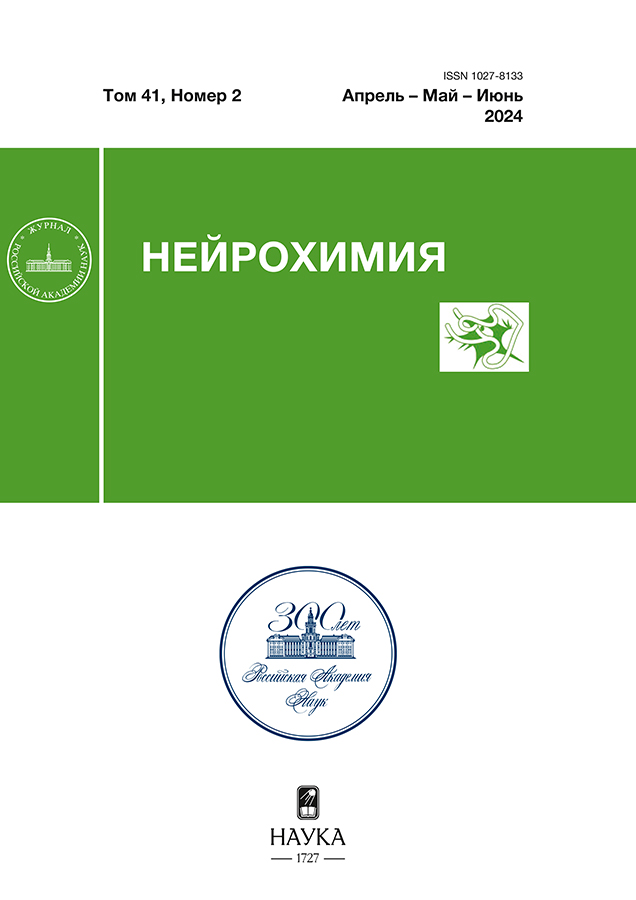Caspase-3 Activity and Autophagy Expression in the Development of Neuronal Resistance to Glutamate Toxicity
- Autores: Aleksandrova O.P.1,2, Kuznetsova D.V.3, Lyzhin A.A.1, Khaspekov L.G.1, Gulyaeva N.V.1, Yakovlev A.A.2,4
-
Afiliações:
- Brain Research Center at Research Center of Neurology
- Institute of Higher Nervous Activity and Neurophysiology, Russian Academy of Sciences
- First Moscow State Medical University named after I.M. Sechenov
- Moscow Research & Clinical Center for Neuropsychiatry, Moscow Research & Clinical Center for Neuropsychiatry
- Edição: Volume 41, Nº 2 (2024)
- Páginas: 140-146
- Seção: Experimental Articles
- URL: https://cardiosomatics.ru/1027-8133/article/view/653899
- DOI: https://doi.org/10.31857/S1027813324020041
- EDN: https://elibrary.ru/ETIUMZ
- ID: 653899
Citar
Texto integral
Resumo
Two periods of autophagy activation, differently significant for the development of resistance, were demonstrated in the model of neuronal resistance to the toxic effect of glutamate (deprivation of trophic factors). The autophagy inhibitor 3-methyladenine (3-MA) at a concentration of 1.25 mM significantly suppresses resistance development, but only if applied immediately after deprivation of trophic factors. Inhibition of autophagy with 3-MA immediately during deprivation does not affect resistance production. In addition, activation of autophagy is responsible for the decrease in caspase-3 activity, although the mechanism of this process remains unclear. We hypothesize that resistance production in neurons is mediated by a decrease in caspase-3 activity as a result of autophagy activation.
Palavras-chave
Texto integral
Sobre autores
O. Aleksandrova
Brain Research Center at Research Center of Neurology; Institute of Higher Nervous Activity and Neurophysiology, Russian Academy of Sciences
Email: al_yakovlev@rambler.ru
Rússia, Moscow; Moscow
D. Kuznetsova
First Moscow State Medical University named after I.M. Sechenov
Email: al_yakovlev@rambler.ru
Rússia, Moscow
A. Lyzhin
Brain Research Center at Research Center of Neurology
Email: al_yakovlev@rambler.ru
Rússia, Moscow
L. Khaspekov
Brain Research Center at Research Center of Neurology
Email: al_yakovlev@rambler.ru
Rússia, Moscow
N. Gulyaeva
Brain Research Center at Research Center of Neurology
Email: al_yakovlev@rambler.ru
Rússia, Moscow
A. Yakovlev
Institute of Higher Nervous Activity and Neurophysiology, Russian Academy of Sciences; Moscow Research & Clinical Center for Neuropsychiatry, Moscow Research & Clinical Center for Neuropsychiatry
Autor responsável pela correspondência
Email: al_yakovlev@rambler.ru
Rússia, Moscow; Moscow
Bibliografia
- Iadecola C., Anrather J. // Nat. Neurosci. 2011. V. 14. № 11. P. 1363—1368.
- Dirnagl U., Becker K., Meisel A. // Lancet Neurol. 2009. V. 8. № 4. P. 398—412.
- Liu J., Gu Y., Guo M., Ji X. // CNS Neurosci. Ther. 2021. V. 27. № 8. P. 869—882.
- Yakovlev A.A., Gulyaeva N.V. // Biochemistry (Moscow). 2015. V. 80. № 2. P. 163—171.
- Yakovlev A.A., Lyzhin A.A., Aleksandrova O.P., Khaspekov L.G., Gulyaeva N.V. // Biochem. Mosc Suppl B Biomed. Chem. 2020. V. 14. № 1. P. 1—5.
- Park H.K., Chu K., Jung K.H., Lee S.T., Bahn J.J., Kim M., Lee S.K., Roh J.K. // Neurosci. Lett. 2009. V. 451. № 1. P. 16—19.
- Wei H., Li Y., Han S., Liu S., Zhang N., Zhao L., Li S., Li J. // Transl. Stroke Res. 2016. V. 7. № 6. P. 497—511.
- Laplante M., Sabatini D.M. // Cell. 2012. V. 149. № 2. P. 274—293.
- Salvesen G.S., Dixit V.M. // Cell. 1997. V. 91. № 4. P. 443—446.
- Ding Z.M., Wu B., Zhang W.Q., Lu X.J., Lin Y.C., Geng Y.J., Miao Y.F. // Int. J. Mol. Sci. 2012. V. 13. № 5. P. 6089—6101.
- Yakovlev A.A., Lyzhin A.A., Aleksandrova O.P., Khaspekov L.G., Gulyaeva N.V. // Biomed. Khim. 2016. V. 62. № 6. P. 656—663.
- Yakovlev A.A., Lyzhin A.A., Aleksandrova O.P., Khaspekov L.G., Gulyaeva N.V. // Biomed. Khim. 2019. V. 65. № 5.
Arquivos suplementares












